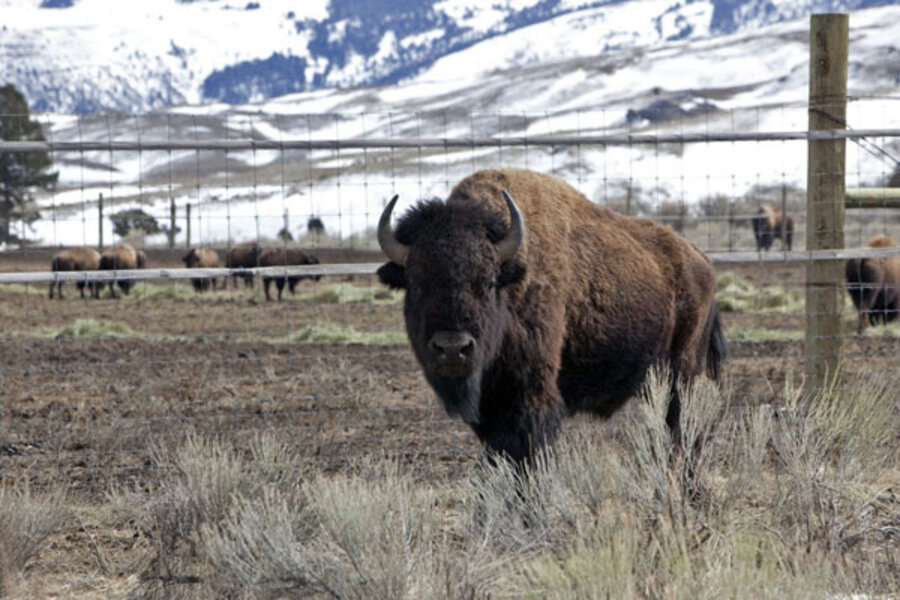Bison reach Montana as part of relocation plan
Loading...
Sixty-four bison from Yellowstone National Park were shipped almost 500 miles to northeast Montana's Fort Peck Reservation on Monday, under a long-stalled relocation initiative meant to repopulate parts of the West with the iconic animals.
The transfer — anticipated for months — came in the middle of a snowstorm and with no prior public announcement, as state and tribal officials sought to avoid a courtroom battle with opponents worried about bison competing with cattle for grazing space.
Montana Gov. Brian Schweitzer described the move as a major step in efforts to restore Yellowstone's genetically-pure bison across a larger landscape.
"This is where we're going to establish the beachhead of genetically pure bison that will be available as their numbers grow to go to other reservations and other public lands all across the West," Schweitzer said.
Tribal and state officials signed an agreement Friday allowing the transfer to take place, said Robert Magnan with the Fort Peck Fish and Game Department.
Caught off guard were landowners and property rights groups that opposed the relocation. They filed a request for a temporary restraining order Monday afternoon to halt the move.
Helena attorney Cory Swanson said moving the animals without public notice following years of controversy amounted to a "sneak attack."
After state district Judge John McKeon in Glasgow did not rule on the request by the close of business Monday, Swanson said he would return Tuesday with a request for the animals to be ordered back to the Yellowstone area.
For the Assiniboine and Sioux tribes of Fort Peck, tribal leaders said the relocation offers a chance to revive their connection with an animal that historically provided food, clothing and shelter for their ancestors.
The trip from Yellowstone was capped by a welcoming caravan of tribal members who fell into line behind the trailers that carried the bison across the Missouri River and onto the reservation.
QUIZ: Are you scientifically literate?
Dozens of tribal members crowded the pen as the bison were unloaded in a field 25 miles north of Poplar, their camera flashes spooking several animals until officials forced back the onlookers. A drum group gathered to sing a traditional song of welcome.
"What we are seeing now is the purebreds. We are bringing them back home," said Ed Bauer, a Fort Peck tribal councilman.
Most bison, also known as buffalo, are hybrids that have been interbred with cattle. Yellowstone's animals are said to represent one of the world's last remaining reservoirs of pure bison genetics.
"One of the main things we're trying to do is preserve the genetic integrity of these animals," Magnan said. "The cultural links from those genetics will be the closest to the bison of our ancestors."
Details of the shipment were kept quiet until it was under way. Magnan said the state and tribes were trying to avoid an injunction after Swanson's clients filed a lawsuit in state district court in January seeking to block the transfer.
Schweitzer said there was no attempt to keep the relocation under wraps, adding that the state did not finalize the agreement with the tribe until late Friday.
Prior attempts to relocate Yellowstone bison failed because of opposition from cattle producers and difficulty finding public or tribal land suitable for the bison.
State wildlife officials have said the relocation of the Yellowstone bison may help answer the question of whether the species can be successfully reintroduced to some public lands in Montana. Aggressive hunting in the 19th century wiped out the vast herds of millions of bison that once roamed freely across most of North America.
Interior Sec. Ken Salazar, who oversees most federal lands in the West, applauded Monday's transfer. Salazar has said further Yellowstone bison relocations are under consideration for public lands in Colorado, South Dakota and elsewhere.
About half of the animals heading to Fort Peck could be transferred later this year to the Fort Belknap Indian Reservation in central Montana. Fences for those animals have not yet been completed.
For the past several years, the animals have been confined to quarantine just north of the Yellowstone.
They were captured leaving the park during their winter migration and tested extensively to make sure they were free of brucellosis. That disease, which can cause pregnant animals to abort their young, was for many years the primary argument for preventing Yellowstone bison from roaming freely outside the park.
But critics of the relocation have lingering worries about bison competing with cattle for rangeland.
State Sen. Rick Ripley, a Wolf Creek Republican and plaintiff in the landowners' lawsuit, criticized Monday's move and said it was in defiance of a law passed last year that required officials to come up with a state-wide bison management plan before moving the animals.
"They just seem to think they are above the law," Ripley said. "They're going to have a lot of problems with damage to private property that they could have addressed prior to translocation."
QUIZ: Are you scientifically literate?
Schweitzer aide Mike Volesky said the new law requires a management plan specific to transferred bison, not a state-wide plan.
The 64 bison and their offspring will remain inside a fenced compound on the reservation, Magnan said.
The tribes already have about 200 bison in a commercial herd used for meat and hunting. A 65th bison that was scheduled to be transferred Monday recently died after getting gored by another bison, Schweitzer said.







